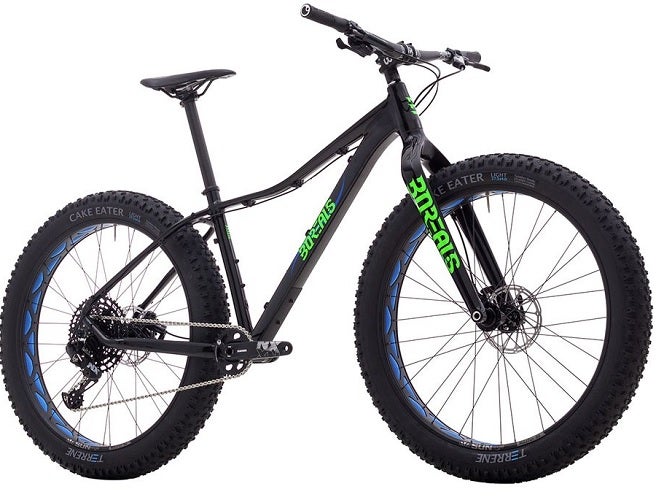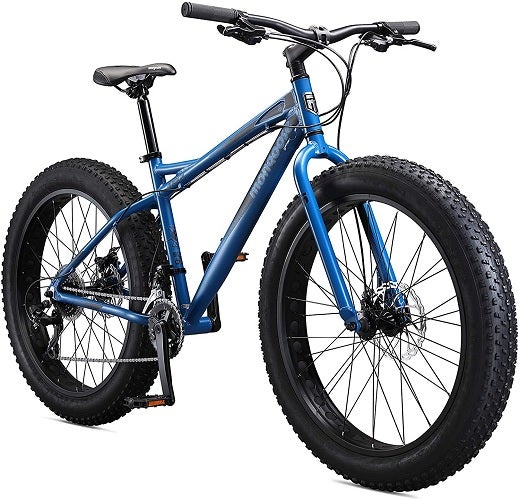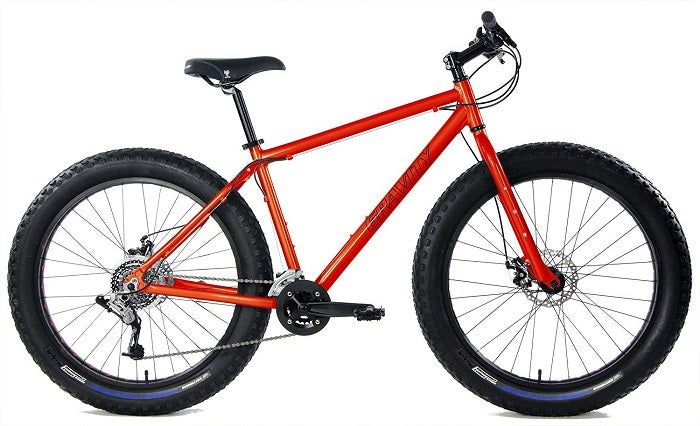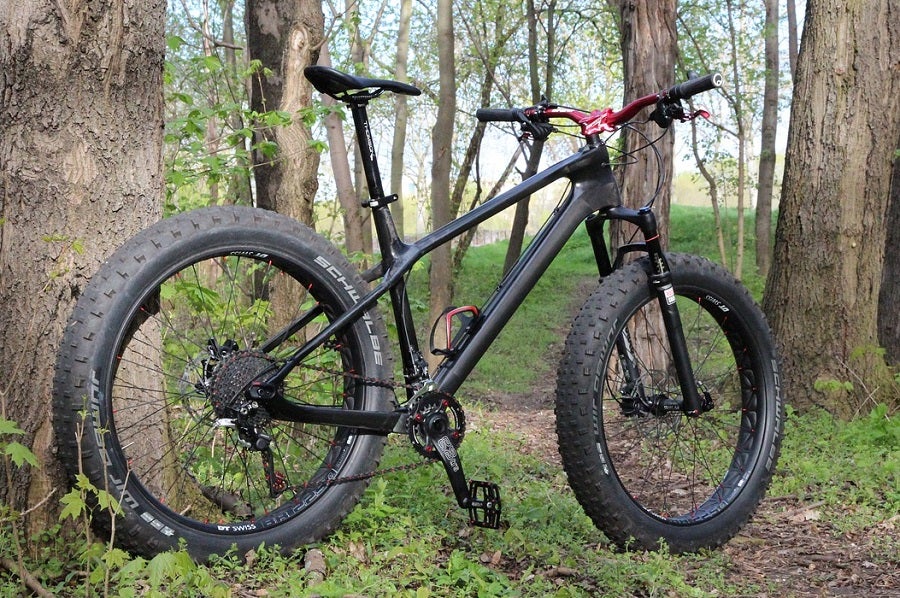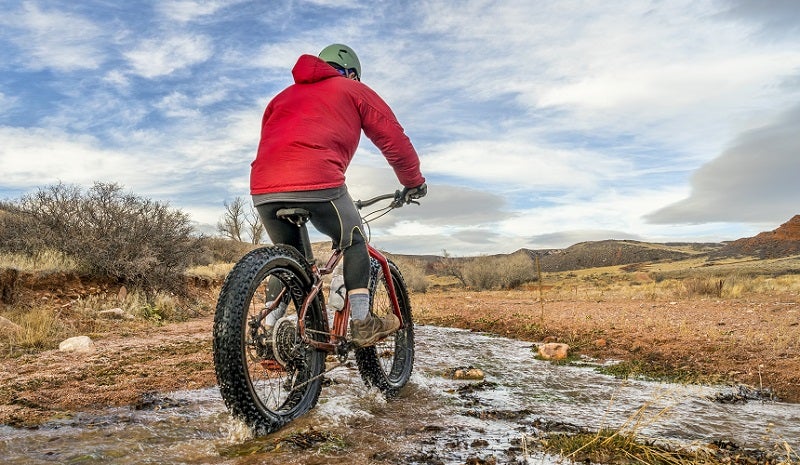
Our Editors independently research, test, and rate what we feel are the best products. We use affiliate links and may receive a small commission on purchases.
Fat tire bikes or fat bikes for short are off-road bicycles with oversized tires and rims. They’re designed for low inflation pressure to give you a smooth ride over rough obstacles.
The best fat bikes are the perfect companion to ride off the beaten track on sand, snow and ice as well as muddy or rocky underground.
Fat tire bikes are popular with adventure riders as well as beginners because their huge tires allow you to plow comfortably and stable over rough terrain.
We’ve reviewed the top fat tire bikes and compiled a guide on how to select one that suits you best.
Looking for a different type of bike? Read our comprehensive guide to every type of bicycle.
Best Fat Bikes
For more of my biking gear recommendations, have a look through these popular Outside Pursuits guide links: Bike Helmets, Bike Lights, Bike Locks, Bike Racks.
Quick Answer: The 7 Best Rated Fat Bikes For 2021
- Mongoose Dolomite Fat Tire Bicycle
- Borealis Bikes Flume NX Eagle Complete Fat Bike
- Mongoose Juneau Fat Tire Bike
- Framed Minnesota LTD Fat Bike
- Diamondback Bikes El Oso Tres Fat Mountain Bike
- Gravity Bullseye Monster Aluminum Fat Bike
- Diamondback El Oso Grande Fat Mountain Bike
Here is a feature comparison of my top rated fat bikes with a comparison table and our buyers guide below will help you choose a good fat bike for you.
Fat Tire Bike Reviews
#1 Mongoose Dolomite Fat Tire Bicycle
- Size: L (18″)
- Tires: 26″ x 4″ Kenda Juggernaut
- Rims: 80mm wide with cutouts
- Frame: Full alloy frame
- Fork: Rigid full alloy with 150mm spacing
- Gears: 7 speed (1×7), Shimano M-379 shifters
- Brakes: Mechanical disc brakes with 180/180mm rotors
The Mongoose Argus Sport fat tire bike is an extremely affordable fat tire bike with features and versatility usually found on bikes costing much more.
You can get this model in large or 18”, suitable for riders with a body height of 5’6” to 6′ and is built on a beach cruiser frame and not designed for heavy mountain biking.
Frame
Mongoose uses a full alloy construction both for the frame and the rigid fork, which can accommodate tires of a width up to 4.5”. Mounted on this model are 26” x 4” Kenda Juggernaut tires on 80mm rims with cutouts to reduce weight.
The lightweight frame paired with the mammoth-sized tires makes rolling over difficult terrain easy, and you’ll coast nicely on snow or sand with a low inflation. You’ll be hugging turns reliably and owning those tracks inaccessible to regular mountain bikes
Brakes & Drive Train
Stopping power comes from mechanical disc brakes with 180mm rotors in the front and rear. It has 7 gears so you have a bit less versatility compared to a more typical 11 speed model.
The 1×7 Shimano drivetrain is paired with a Sunrace cassette, allowing you to select the right gear for each climb or downhill race.
The Mongoose Argus Sport is the best budget fat bike suitable for year-round riding on a range of difficult terrains, and at this price, there’s no reason not to enter the fatbike craze.
#2 Borealis Bikes Telluride GX Eagle/Mastodon Fat Bike
- Size: One Size
- Tires: 27.5 x 4in, Terrene Cake Eater
- Rims: Mulefut 27.5 x 80mm
- Frame: Butted 6061-T6 aluminum, fits up to 5″ tires
- Fork: 15 x 150mm Thru-Axle
- Gears: 12 Speed, SRAM XG-1275 GX Eagle
- Brakes: SRAM Guide RS hydraulic disc 180mm
The Borealis Bikes Telluride GX is our editor’s choice for the best fat bike and a versatile for many different situations.
It’s fun to ride and not that much different from a regular mountain bike if you ride it on regular trails, but you’ll get amazing performance once you go off-road.
This fatbike excels on snow and on sand but is not limited to these surfaces.
Frame
The Telluride GX is indeed built like a bear: Borealis has selected a strong and light-weight aluminum frame with hydroformed tubing for extra smooth riding on bumpy trails.
Frame and fork can accommodate 27.5 tires up a width of 5”. The Telluride GX comes with 27.5” x 4” Terrene Cake Eater mounted on Borealis 27.5 x 80mmrims.
Tires
These tires feature a high volume with low pressure and enable you to gain traction on trails and surfaces that have been unrideable before. Lower the pressure and experience the amazing feeling of floating along. Even when you don’t ride on sand or snow, you’ll be coasting along smoothly.
Drive Train
The Telluride GX comes with a 12 Speed, SRAM XG-1275 GX Eagle drive train and all Shimano derailleur, shifters and cogset. This setup gives you a total of 12 gears and is impossible to cross, enabling you to use all combinations.
Another advantage is the low clearance of the front cogwheel, making it less susceptible for bump damage. For safe braking, the bike has a SRAM Level T hydraulic disc brake with 180mm rotors in the front and back.
The Borealis Bikes Telluride GX is available in one size and fit rider’s height from approximately 5’4″ to 6’2″.
I think it’s the best fatbike that performs well on trails, snow or sand and is perfect for beginners to advanced riders who’ll appreciate the quality build and components on this fatbike.
Check Price & Availability on CompetitiveCyclist.com
#3 Mongoose Juneau 26-Inch Fat Tire Bike
- Size: One size
- Tires: 26″ x 4″ Spider E/V big tires
- Rims: Cora 26″ alloy rims
- Frame: Hydro-formed aluminum
- Fork: Rigid Corsa steel fork
- Gears: 16 speed (2×8), Shimano Tourney trigger shifters
- Brakes: Promax disc brake
The Mongoose Juneau is one of the best fat tire bikes for the trail and off-road exploring. It comes with a lightweight and sturdy alloy frame and a rigid Corsa steel fork.
You can use this fat tire bike with a wide range of different tire pressures for just a little flotation or the full fatbike experience.
Tires
With wide 26” by 4” Spider tires mounted on Cora alloy rims, the bike will ride smoothly through all terrain in all weather conditions. The tires have deep and thick knobs to give you traction on tricky surfaces like snow, sand and dirt.
Drive Train
The Alton Mammoth has an all Shimano drivetrain with Shimano Deore front derailleur, Shimano Tourney rear derailleur and Shimano Alivio shifters.
A 2×8 speed setup gives you a total of 16 gears for low-end flexibility when climbing steep hills and sufficient high-end speed when bombing downhill or riding on concrete and more accessible trails.
Brakes & Size
Thanks to Promax disc brakes, safety is ensured and you can fully control your stops.
The bike only comes in one size for riders from roughly 5’4″ to 6’2″.
The Mongoose Juneau is a gentle giant that rides with ease. Available at an entry-level price, this fat tire bike will not only appeal to beginners of the sport but just about anyone who wants to try a fat bike!
#4 Framed Minnesota Fat Bike
- Size: 18″, 20″, 22”
- Tires: Framed Minnesota 26″ x 4″ 120 tpi Wire Bead
- Rims: 26″ framed alloy singlewall rims, 70mm wide
- Frame: Framed oversized 6061 aluminum alloy frame
- Fork: Rigid Framed, fits wheels from 26″ x 4.0″ to 29″ x 2″ (135mm QR)
- Gears: 11 speed (1×11), SRAM X5 shifters
- Brakes: Avid BB5 mechanical disc brake, 160mm rotors
The Framed Minnesota fat tire bike is for the price-conscious rider who nonetheless demands advanced features and high-quality materials.
For less than $1000, this model delivers everything you need for riding bumpy trails, explore dirt paths and bogs or coast over snow and dunes. It will also look great and perform well during your regular commute or a Sunday country ride.
Frame & Tires
This fat tire bike is built with an oversized 6061 aluminum alloy frame for durability, paired with a rigid aluminum alloy fork.
Framed has mounted 26” x 4” fat tires with lightweight tubes on 3.14” wide alloy singlewall rims, which feature cut-outs to reduce the weight and are double pinned for further weight reduction and maximized strength.
The 120 tpi folding bead tire has the perfect pattern for best performance year-round.
Drive Train
The 1×11 drivetrain delivers a total of 11 gears with SRAM X5 shifters and an all SRAM drivetrain. You cannot cross these gears and can rely on easy shifting and performance in any riding conditions.
The gears act with precision and no shifting variation. Stopping power is delivered by Avid BB5 mechanical disc brakes.
This fatbike has 3 sizes available 18″, 20″, 22” so there should be one that fits you perfect.
The Framed Minnesota 2.0 is one of my top picks for the best fat bike in a cost-effective package. Its race-ready and feature-rich, you can take your off-roading to the next level with this fat tire bike.
#5 Diamondback El Oso Tres Fat Mountain Bike
- Size: S (16″), M (18″), L (20″)
- Tires: 26″ x 4.5″ Chaoyang Cruiser
- Rims: 32h Diamondback, 75Wide with 28mm cutouts, alloy singlewall
- Frame: Aluminum, 1-1/8″ headtube, can accommodate up to 26″ x 5″ tires
- Fork: Rigid DB El Oso custom steel fork, 135mm QR disc dropouts
- Gears: 11 speed (1×11), Shimano SLX M7000
- Brakes: Shimano MT500 hydraulic disc
This is the top of the line model of the Diamondback El Oso (“The Bear”) series. The El Oso de Acero is a fat tire bike designed more as a mountain bike than a fatbike.
You can ride it like a dune buggy or snowmobile, hop over rocks with it and bomb down hills and trails, yet it looks as slim and refined as a city bike.
Frame
The Diamondback El Oso comes with a sleek, elegant aluminum frame to provide strength, durability and ride quality, paired with pleasing aesthetics.
Butted and heat-treated tubes give you a riding quality full of compliance, on top of 26” x 4.5” cruising tires. The frame can accommodate a tire width of up to 5”. The rims are alloy singlewall with cutouts to reduce weight.
Brakes & Drive Train
With solid Shimano parts, you can rely on this fatbike: the hydraulic disc brake delivers powerful stops, and an all Shimano 1×11 drivetrain gives you a total of 11 gears, enough for all situations on the trail, off-roads or climbing hills.
The Diamondback El Oso is available in the three sizes S, M, and L, 16″, 18″ and 20″, which the manufacturer pairs with an approximate rider’s height of 5’4″ to 5’7″, 5’7″ to 5’10”, and 5’8″ to 5’11”.
This fat tire bike is a dependable workhorse and the best fatbike under $2000.
#6 Gravity Bullseye Monster Aluminum Fat Bike
- Size: 14″, 16″
- Tires: 26″ x 4″ V-Rubber Mission Wire Bead
- Rims: 26″ x 32H 80mm alloy with big cutouts
- Frame: Alloy 6061 frame, with disc mount, tig weld
- Fork: Rigid 26″ CrMo with threadless steerer 1.125″
- Gears: 16 speed (2×8), Shimano Alivio and SRAM drivetrain with SRAM shifters
- Brakes: Tektro Novela disc brake with 160/160mm rotors
The Gravity Bullseye Monster fat tire bike will appeal to a lot of different riders and comes in two sizes. The 14” mode will 14″ fit most 5’4″ to 5’7″ riders, 16” is for 5’7″ to 5’10”.
With 26” x 4” tires, you can roll over virtually anything and make full use of the fat tires in winter. Float over snow and sand, go for adventures in mud and bogs and finally conquer those hard trails.
Frame
With compact specs and an aluminium alloy construction, the Gravity Bullseye Monster keeps weight down and his a heavyweight champion nonetheless in terms of performance.
The alloy frame is paired with a rigid alloy form, sufficient enough to deal with bumps and shocks in combination with those fat tires.
Brakes & Drive Train
Don’t be afraid of stopping, because the Tektro Novela disc brakes deliver power and precision. 16 gears allow you to pedal and your desired rate in all situations, and with a 2×8 drivetrain, crossing gears is impossible. Shifting is fast and precise.
The Gravity Bullseye Monster is to a mountain bike what a monster truck is to a regular car. There is hardly a place you can’t go with this beast, and you’ll definitely get noticed on the trail or cruising along on the street.
Overall, the Gravity Bullseye Monster is the best cheap fat bike!
#7 Diamondback Bikes El Oso Grande Fat Mountain Bike
- Size: S (16″), M (18″), L (20″)
- Tires: 26″ x 4.9″ Chaoyang Cruiser
- Rims: DB 95wide w/55mm cutout, singlewall 32h
- Frame: Butted 6061-T6 aluminum, 197mm thru axle, fits up to 26″ x 5″ tires
- Fork: Rigid DB El Oso custom alloy fork, 1.5 taper, 150mmx15mm thru
- Gears: 20 speed (2×10), SRAM X5 shifters, SRAM drivetrain
- Brakes: TRP Spyre mechanical disc, 160mm/160mm rotors
This is the “Big Bear” in the Diamondback El Oso series, with tires nearly 5” wide and built for power, strength and durability.
The Diamondback El Oso Grande is an impressive-looking beast, yet is able to deliver speed and smooth riding paired with nimble maneuverability. You could call it an adventure machine suitable for every trail.
Frame
The frame of butted aluminum is rigid, yet designed to shave off pounds. Paired with a rigid custom alloy fork, this fatbike relies entirely on the tires to deliver suspension. Gigantic 26” x 4.9” cruiser tires are up to the job.
You can ride them comfortably even at the lowest PSI. These tires dig their grip into any surface, no matter if you’re bikepacking, going over sand and snow or through mud and wet terrain.
Brakes & Drive Train
Spyre mechanical disc brakes provide the necessary stopping power with adequate 160mm rotors in the front and back.
For excellent modulation and sufficient gears, all of which you can use thanks to a cross-free 2×10 drivetrain, the SRAM setup is paired with a Shimano cassette to give you 20 speed riding power.
The Diamondback El Oso Grande is available in three sizes: S, M, and L, or 16″, 18″ and 20″. Approximate rider’s height is specified as 5’4″ to 5’7″, 5’7″ to 5’10”, and 5’8″ to 5’11”.
Whether you have high demands or just want to go cruising in style with that floating fat tire bike feeling, this fatbike is for you. With lots of features for smooth riding, it’s a beast you need not fear.
Fat Bikes Comparison Table
| Fat Bikes | Size | Tires | Rims | Frame | Fork | Gears | Brakes | |
|---|---|---|---|---|---|---|---|---|
| Mongoose Dolomite Sport Fat Tire Bike | L (18″) | 26″ x 4″ Kenda Juggernaut | 80mm wide with cutouts | Full alloy frame | Rigid full alloy with 150mm spacing | 7 speed (1×7), Shimano M-379 shifters | Mechanical disc brakes with 180/180mm rotors | |
| One Size | 27.5 x 4in, Terrene Cake Eater | Mulefut 27.5 x 80mm | Butted 6061-T6 aluminum, fits up to 5″ tires | 15 x 150mm Thru-Axle | 12 Speed, SRAM XG-1275 GX Eagle | SRAM Guide RS hydraulic disc 180mm | ||
| Mongoose Juneau Fat Tire Bike | One size | 26″ x 4″ Spider E/V big tires | Cora 26″ alloy rims | Hydro-formed aluminum | Rigid Corsa steel fork | 16 speed (2×8), Shimano Tourney trigger shifters | Promax disc brake | |
| Framed Minnesota Fat Bike | 18″, 20″, 22” | Framed Minnesota 26″ x 4″ 120 tpi Wire Bead | 26″ framed alloy singlewall rims, 70mm wide | Framed oversized 6061 aluminum alloy frame | Rigid Framed, fits wheels from 26″ x 4.0″ to 29″ x 2″ (135mm QR) | 11 speed (1×11), SRAM X5 shifters | Avid BB5 mechanical disc brake, 160mm rotors | |
| Diamondback Bikes El Oso Tres Fat Mountain Bike | S (16″), M (18″), L (20″) | 26″ x 4.5″ Chaoyang Cruiser | 32h Diamondback, 75Wide with 28mm cutouts, alloy singlewall | Aluminum, 1-1/8″ headtube, can accommodate up to 26″ x 5″ tires | Rigid DB El Oso custom steel fork, 135mm QR disc dropouts | 11 speed (1×11), Shimano SLX M7000 | Shimano MT500 hydraulic disc | |
| Gravity Bullseye Monster Aluminum Fat Bike | 14″, 16″ | 26″ x 4″ V-Rubber Mission Wire Bead | 26″ x 32H 80mm alloy with big cutouts | Alloy 6061 frame, with disc mount, tig weld | Rigid 26″ CrMo with threadless steerer 1.125″ | 16 speed (2×8), Shimano Alivio and SRAM drivetrain with SRAM shifters | Tektro Novela disc brake with 160/160mm rotors | |
| Diamondback Bikes El Oso Grande Fat Mountain Bike | S (16″), M (18″), L (20″) | 26″ x 4.9″ Chaoyang Cruiser | DB 95wide w/55mm cutout, singlewall 32h | Butted 6061-T6 aluminum, 197mm thru axle, fits up to 26″ x 5″ tires | Rigid DB El Oso custom alloy fork, 1.5 taper, 150mmx15mm thru | 20 speed (2×10), SRAM X5 shifters, SRAM drivetrain | TRP Spyre mechanical disc, 160mm/160mm rotors |
How to Choose the Best Fat Bike – Buyers Guide
- Wheels
- Size & Fit
- Wheels & Dimensions
- Tires
- Terrain
- Fork & Suspension
- Gears
- Brakes
- Frame
- FAQs: About Fat Tire Bikes
Let’s cover the features you need to pay attention to and we’ll explain in more detail how to choose the right fat bike for you! If you plan on using a bike rack to transport your fat bike, be sure it will accommodate the tires! Platform bike racks are an ideal choice.
Wheels
26” wheels used to be a standard for mountain bikes, but now they also come with 27.5” or 29” wheels. So do fatbikes.
With larger wheels, you’ll find it more easy to roll over obstacles as the so-called attack angle is lower. This makes for a smoother ride. However, smaller wheels are more maneuverable.
If you ride very twisty trails and do tight turns, a lower wheel size might be best for you. Larger wheels are great for sustained rolling, i.e. cross-country or through the snow.
Larger sized wheels suit tall riders best: if you’re over 6 feet tall, you’ll feel more comfortable on 29” wheels.
Size & Fit
When sizing and fitting a bike, not only is the wheel size important, but also the frame size. To fully enjoy your fatbike, it should fit you well and match your height, flexibility and riding style.
There is no absolute standard for sizing, but most manufacturers try to make it easier by providing sizes like S, M, and L which correspond to your height. A sizing chart makes matching straightforward.
Pay attention to recommendations for a specific model. If you find yourself between sizes, it’s generally advisable to err on the smaller side as you’ll then find it easier to fully dial in the fit with small accommodations. Visit your local bike shop if you need help.
As a rule of thumb: when you stand over the bike with both feet flat on the ground and legs close together, there should be a clearance of roughly 2.75” to 3.25” between your crotch and the sloping top tube.
Much less and pedalling can become difficult, much more and you’re wasting energy or making pedalling uncomfortable.
Wheels & Dimensions
Each manufacturer might have an individual pairing of fatbike tires with sizes for other parts. As a rule of thumb, the following wheel sizes correspond to these bike dimensions:
- 26+: 26” rims, width > 1.4”, typically 2.0”. Tire width typically > 2.5”, such as 2.8” or 3.0”
- 5+: 27.5” rims, width > 1.4”, typically 2.0”. Tire width typically > 2.5”, such as 2.7”-3.25”
- 29+: 29” rims, width > 1.4”. Tire width typically up to 3.0”
- XL: 26”, width 2.4”-4.1”. Tire width typically > 3.5”, such as 3.8”, 4.5”, or 4.8”
- XXL: 26” rims, width 3.1”-4.1”. Tire width > 5.0”
Tires
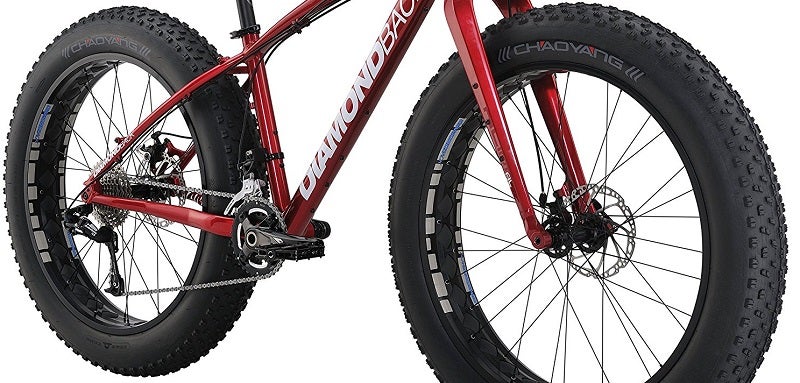
As with many things, fat is actually subjective. So what thickness classifies as fatbike, and which tire size is best suitable for which terrain?
We’ll give you a brief overview. While standard mountain bike tires range between 1.95” and 2.5” in width, fat bike tires are between 3.8” and 5” in width.
Fat bike tires
- 26” x 4” (559 ISO): tire width of the first fat bikes
- 26” x 5” (559 ISO): wider fat tire bikes
- 5” x 4” (584 ISO): new fat size
These tires provide good traction and flotation and absorb trail irregularities well. Plus tires range from 2.8” to 3” in width.
Plus tires
- 26+ (559 ISO): rare tire width
- 27+ (584 ISO): common plus size
- 29+ (622 ISO): biggest size tire
Riding Terrain
Things like geometry, frame size and suspension all influence how a bike performs and feels on the trail, but the tires and their pressure do the work of transferring the energy from your pedalling, braking and steering on to the trail.
For various terrain scenarios, different fat tires are recommended:
- Sand & Snow: Floatation is great for snow and deep sand, so pick the widest tires according to your preference and experiment with an inflation level that works well for you.
- Ice: On ice, you’ll want a low of traction to avoid skipping, so a wide tire with lots of profile is good. But you’ll need to inflate it more than fore sand and snow to avoid squishing and self-steering and therefore loss of control on this slippery surface.
- Mud: Both fat and plus size tires can work well here. Depending on how squishy it gets, you can adjust the inflation to make it through without getting stuck.
- Expedition & Exploration: If you’re heading on a long ride into unknown terrain, it’s a safe bet to pick a bigger and wider tire. What looks like overkill on the road or in areas with no sand or dirt quickly becomes an excellent choice when the going gets tough off-road. Plus tires will balance grip, float and weight well, while a fat tire lets you roll comfortably over obstacles.
- Cross-Country Racing & Fitness Riding: If you want to go fast, wider tires mean more friction and loss of energy, resulting in a slower speed. You’ll deal well with obstacles, but lose on the climb, especially on paved road. Standard tires are best here.
- Downhill, Gravity Riding & Enduro: You’ll need to corner fast and hard, and if you use a fat and less-inflated tire for these situations, you’ll experience tire flexing and squishing. Plus size tires perform better than fully fat tire bikes. Keep the tire pressure up and don’t go too low.
- Dirt Biking & Trail Riding: This is a free-for-all – experiment with tire thickness and inflation level.
Fork & Suspension
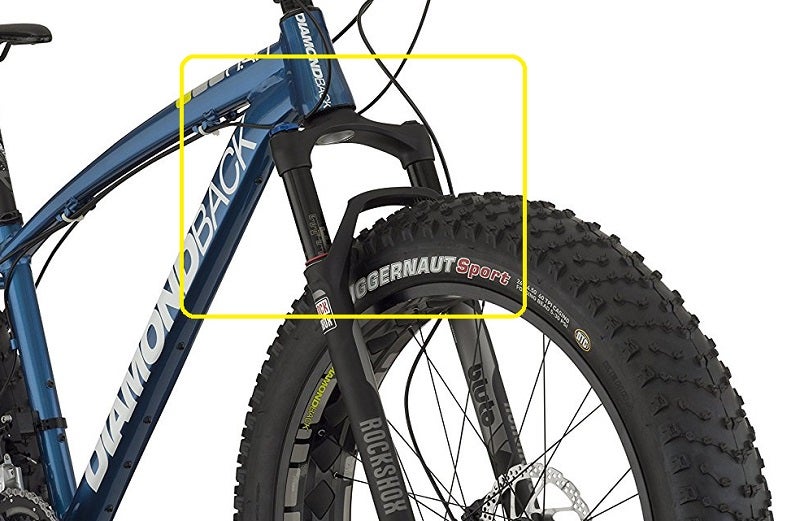
Diamondback Bicycles El Oso Complete Fat Bike
Suspension on a fatbike is less common since the thicker tires paired with a low pressure make for a floating, cushioned ride already. There are three levels of suspension:
- Rigid: A rigid fat tire bike has no suspension other than what the tires provide. Most riders find the squish of the fatbikes sufficient.
- Suspension fork: Also called hardtail suspension because the rear has no suspension. These bikes use a suspension fork with springs or hydraulics, which makes for a smoother ride, especially on downhill stretches. The fork can have the option to lock out the suspension for when you prefer to ride rigid.
- Full suspension: These bikes feature rear shock absorbers for a more cushioned ride. This type is highly uncommon with fat tire bikes.
Gears
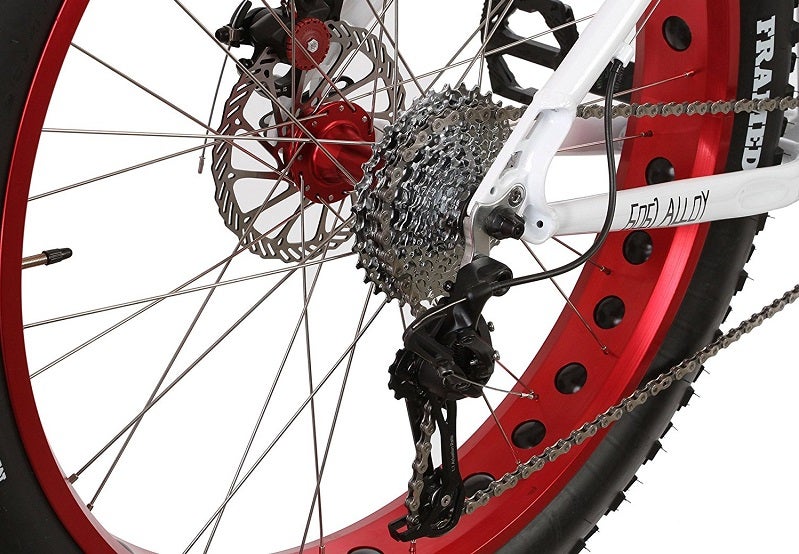
The number of gears on a fat tire bike or any bike with a derailleur gear system is the result of the number of front chainrings multiplied by the number of sprockets on the cassette.
You can have a single speed to 30 or more gears. Gears are generally helpful if you have a lot of climbing to do and prefer easy pedalling with more revolutions and less resistance for that.
The stronger you are, the less gears you need. Keep in mind that fatbikes are slightly heavier than the mountain bike you might be used to.
If you have only one chainring in the front, you only need one shifter to cycle through all the gears, which means less cables and maintenance on your bike.
A low number of gears can be sufficient for many situations, but some riders prefer 20 and more. The choice is yours.
Brakes
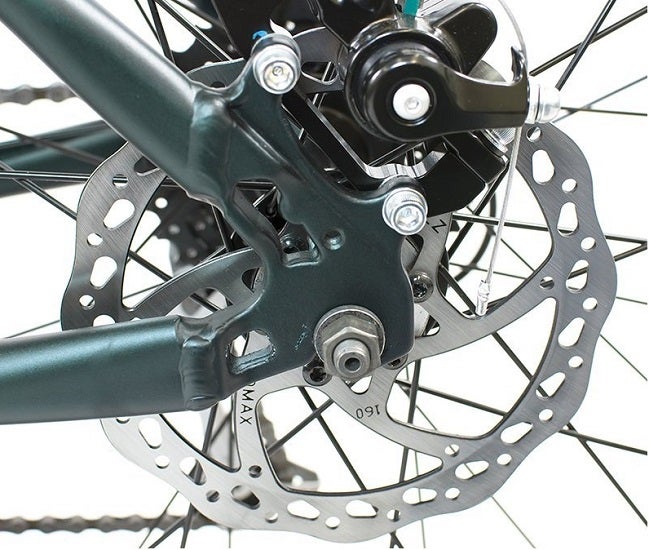
The choice for brakes on your fatbike basically comes down to rim brakes and disc brakes. You’ll typically see rim brakes on entry-level models.
Disc Brakes
A brake rotor (a perforated disc) is mounted to the wheel hub and gripped by the brakes. Mechanical brakes use cables for activation and need manual adjustment as the pads wear out. Hydraulic disc brakes are stronger and self-adjust for brake pad wear. Disc brakes offer consistent braking in all conditions and better performance in steep and wet terrain. A worn disc is cheap and easy to replace. Hydraulic brakes are more difficult to service.
Rim Brakes
These brakes use pads that grip directly onto the rim of the wheel. They’re economical and pad wear is easy to monitor. However, they gradually wear out the wheel rim, have less stopping power (especially in wet conditions) and require more finger effort to brake hard.
Frame
The frame is a bike’s most important structural element. It will influence the bike’s weight (together with those fat tires), strength & performance as well as durability and price.
Aluminum alloy is a common material that is sturdy and comparatively inexpensive while also being light-weight. For a higher price, you can get pure aluminum models which will be lighter.
Alternatives for the frame material are steel, titanium or carbon fiber. Steel is tough, also inexpensive and rides smoothly, but comes with a heavy weight.
You also need to take care of a steel frame to prevent rusting, otherwise it’s very forgiving. Carbon fiber is great for cross-country and fat tire bikes because it’s a strong and resistive material with a low weight, but it’s also more expensive to produce.
FAQs About Fat Tire Bikes
Q: What is a fat tire bike?
A: Fat tire bikes are known as fatbikes for short, but you might also hear them called snow bikes, all-terrain bikes or ATBs. Their most prominent feature are the wider than normal tires.
To accommodate these, fatbikes also use a wider fork, bottom bracket, and rear triangle to make room for the wide rims. Tire width can go to 5” or more with rims as wide as 4”.
Fat tire bikes are typically ridden at low tire pressure, which gives you good stability at low speeds and the ability to ride on loose material such as sand or snow as well as over obstacles.
Q: What tire pressure should I use with my fat bike?
A: Select the pressure you are comfortable with – every rider has their own preference. With fatbikes, the saying goes: “When in doubt, let air out” – but carry a portable bike pump to re-inflate when there is need.
Start by gradually lowering the pressure and check how you enjoy riding it. For riding on snow or sand, between 5 and 10 psi seems to yield good results. Keep in mind that at too low a pressure, your rims might start bumping on the ground, resulting in damage. You’ll also shorten tube lifespan at lower pressures. Around 3 psi is a good lower limit.
As a general rule: harder terrain requires higher pressure, softer terrain lower pressure. You might reach limitations, for example loose beach or dune sand, powder snow, shale and pea gravel.
Downhill riding is always easier, but climbing requires more traction, and even the fattest tire at the lowest inflation can bog down eventually.
Q: Any tips for riding on snow or sand with a fat tire bike?
A: Whatever you do, ease into it and take it slow, especially if you’re still getting used to your new fat tire bike. Start with a tire pressure between 5 and 7 psi. Many trails for fatbikes actually have recommendations for tire pressure.
Make sure your bike is well adjusted to your body and height. If you have trouble getting traction on loose material, keep you weight over the back tire (i.e. don’t lean forward) and pedal evenly. If you’re still getting stuck, gradually let some air out of the tires.
When riding on snow, check conditions beforehand. Powder is entirely different from packed and frozen snow. Tires with low inflation don’t perform well on ice.
When you spot a patch of ice, go slow and break before it, not on it. Stay straight with your balance centered, and don’t turn on the ice. If need be, get off and walk your bike.
Q: What surface conditions are best for fatbikes?
A: Fat tire bikes can feel amazing when you’re off-road and exploring fresh tracks. But like all bikes, they actually work better on harder surfaces. For snow and sand, firm and condensed will be better than loose.
If the trail has been groomed, it will be much more rideable. For sand and dirt trails, paths and trails that are used by quad or motorcycle riders will work for fatbikes. In the snow, snow that has been backed by skis, snowshoes or snowmobiles works great. More than a few inches of new snow are generally not rideable.
If chunks of snow are sticking to your tires or you cannot go in a straight line, skiing is probably the better way to go. Always check conditions before you go on a ride.
Q: Do I have to assemble the bike myself?
A: When ordering a bike, they will be shipped to you partially assembled. The details depend on the manufacturer, but typically you have to attach the wheels and pedals, straighten the handlebars, inflate the tires and adjust everything to your size.
On some models, you might have to insert the chain into the drivetrain. You will receive an owner’s manual with detailed instructions, but if you’re not comfortable with the assembly, bring the bike to a local shop to get assistance.
Conclusion
Remember to select the size well for your fat tire bike to match your body. Choose fatter tires if you have more aggressive use in mind, and don’t hesitate to experiment with inflation to find out the perfect PSI for various terrains and to achieve that great floating sensation when riding along.
Fatbikes are a lot of fun and come with a built-in smile factor – you can’t help but grin to yourself, because riding one feels very different from a regular mountain bike.
We hope our selection and guide are useful to you in taking your trail rides and off-road adventures to the next level!
I hope this guide was helpful for finding the best fatbike to fit your needs. If you want to comment or recommend a bike I didn’t include, please use my contact form to get in touch.
How We Researched
To come up with the top fat tire bikes, we researched a variety of sources for reviews such as CompetitiveCyclist, JensenUSA, REI, EVO along with our own personal experience.
We also consulted online magazines for product research and reviews to get as much unbiased information as we could. To help weed out fake reviews we used Fakespot.com to make sure we only looked at genuine reviews.
With so many quality bikes available, we had to narrow it down based on what we felt were the best options for the price. The staff authors have a wide and varied background in road cycling, racing and bike packing.
The authors have decades of experience in cycling and eager to share their knowledge with readers.
To help narrow down the selection we used personal experiences along with recommendations from fellow cyclists, bloggers and bike shops.
After extensive research, we came up with our list to help you choose the right bike for you.

